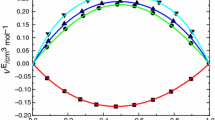Abstract
Densities and viscosities of binary mixtures of Propiophenone with o-xylene, m-xylene and p-xylene were measured over the entire composition range at T=(303.15 to 318.15) K and at 0.1Mpa atmospheric pressure. Experimental data used to calculate excess molar volume (VE), deviation of viscosity (Δη), excess Gibb’s free energy (G*E) activation of viscous flow for each binary system and the results were fitted to the Redlich-Kister polynomial equation to obtain the fitting coefficients and standard deviations. Viscosity values used to compute single adjustable interaction parameters from Grunberg and Nissan, Katti and Chaudhri, Hind et al., Tamara Kurata and Frenkel relations. Deviations in thermodynamic properties of the binary mixtures were discussed in terms of their molecular interactions between the components. Viscosity data correlated with the McAllister’s three body/four body models, Heric, Auslander, and Jouyban-Acree relations having two and three adjustable parameters for the studied binary mixtures. Viscosity relations like Kendall-Monroe, Bingham, Arrhenius, and Kendall were used to calculate and compare the standard deviation percentage, (σ %), between the experimental and calculated viscosity data. The studied systems showed specific intermolecular interactions and the percentage deviations were in good agreement with the experimental values. Obtained results are useful in various chemical and industrial processes.
Similar content being viewed by others
References
S. K. Bindhani, G. K. Roy, Y. K. Mohanty and T. R. Kubendran, Russ. J. Phys. Chem. A, 89, 1828 (2015).
Y. Zhou, J. Wu and E. W. Lemmon, J. Phys. Chem. Ref. Data, 41 (2012), DOI:https://doi.org/10.1063/1.3703506.
J. A. Al-Kandary, A. S. Al-Jimaz and A. H. M. Abdul-Latif, J. Chem. Thermodyn., 38, 1351 (2006).
S. Singh, B. P. S. Sethi, R. C. Katyal and V. K. Rattan, J. Chem. Eng. Data, 50, 125 (2005).
G. Moumouzias, C. Ritzoulis and G. Ritzoulis, J. Chem. Eng. Data, 44, 1187 (1999).
J. A. Al-Kandary, A. S. Al-Jimaz and A. H. M. Abdul-Latif, J. Chem. Eng. Data, 51, 2074 (2006).
M. Habibullah, K. N. Das, I. M. M. Rahman, M. A. Uddin, K. Saifuddin, K. Iwakabe and H. Hasegawa, J. Chem. Eng. Data, 55, 5370 (2010).
A. Ali and F. Nabi, Acta Phys. - Chim. Sin., 24, 47 (2008).
S. Gahlyan, S. Verma, M. Rani and S. Maken, Korean J. Chem. Eng., 35, 1167 (2018).
F. Corradini, G. Franchini, A. Marchetti, M. Tagliazucchi and L. Tassi, Bull. Chem. Soc. Jpn., 68, 1867 (1995).
Z. Begum, P. B. Sandhya Sri, D. B. Karuna Kumar and C. Rambabu, J. Mol. Liq., 178, 99 (2013).
S. K. Bindhani, G. K. Roy, Y. K. Mohanty and T. R. Kubendran, Russ. J. Phys. Chem. A., 91, 1037 (2017).
G. S. Manukonda, P. Venkatalakshami and K. Rambabu, Int. J. Phys. Res., 3, 5 (2013).
P. Jain and M. Singh, J. Chem. Eng. Data, 49, 1214 (2004).
M. V. Rathnam, S. Mohite and M. S. S. Kumar, J. Solution Chem., 39, 1735 (2010).
S. Fakruddin, C. Srinivasu, B. R. Venkateswara Rao and K. Narendra, Adv. Phys. Chem., 2012 (2012), DOI:https://doi.org/10.1155/2012/324098.
S. C. Bhatia, R. Rani and R. Bhatia, J. Mol. Liq., 159, 132 (2011).
A. Krishnaiah and K. N. Surendranath, J. Chem. Eng. Data, 41, 1012 (1996).
L. Grunberg and A. H. Nissan, Nature, 164, 799 (1949).
P. K. Katti, M. M. Chaudhri and O. M. Prakash, J. Chem. Eng. Data, 11, 593 (1966).
R. K. Hind, E. McLaughlin and A. R. Ubbelohde, Trans. Faraday Soc., 56, 328 (1960).
M. Tamura and M. Kurata, Bull. Chem. Soc. Jpn., 25, 32 (1952).
Frenkel Ya., I., Petroleum, 9, 27 (1946).
J. Kendall and K. P. Monroe, J. Am. Chem. Soc., 39, 1787 (1917).
P. D. Eugene and C. Bingham, Fluidity and Plasticity, Cambridge University Press, Cambridge (1922), DOI:https://doi.org/10.1017/CBO9781107415324.004.
S Arrehenius, Meddelanden Från K. Vetenskapsakademiens Nobelinstitut, Nobel Inst. 2, 25 (1913).
A. K. Nain, R. Sharma, A. Ali and S. Gopal, J. Mol. Liq., 144, 124 (2009).
A. K. Nain, R. Sharma, A. Ali and S. Gopal, Int. J. Thermophys., 31, 1073 (2010).
S. Oswal and M. V. Rathnam, Can. J. Chem., 62, 2851 (1984).
R. J. Fort and W. R. Moore, Trans. Faraday Soc., 62, 1112 (1966).
L. Pikkarainen, J. Chem. Eng. Data, 28, 381 (1983).
T. M. Reed and T. E. Taylor, J. Phys. Chem., 63, 58 (1959).
R. Nigam, Indian J. Chem., 9, 1255 (1971).
O. Redlich and A. T. Kister, Ind. Eng. Chem., 40, 345 (1948).
Author information
Authors and Affiliations
Corresponding author
Rights and permissions
About this article
Cite this article
Ramachandran, D., Devi, N.G. & Srinivasa Rao, N.V.N.B. Correlative and predictive models of viscosity study on Propiophenone with isomeric xylenes binary mixtures at T=(303.15 to 318.15) K. Korean J. Chem. Eng. 35, 1919–1931 (2018). https://doi.org/10.1007/s11814-018-0104-y
Received:
Accepted:
Published:
Issue Date:
DOI: https://doi.org/10.1007/s11814-018-0104-y




